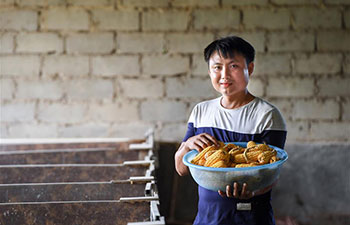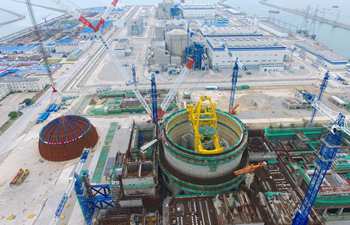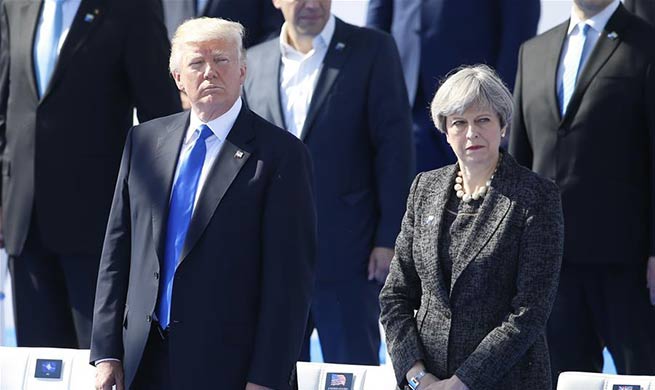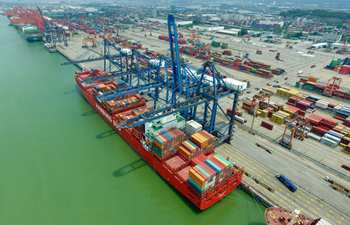TOKYO, May 26 (Xinhua) -- Japan's core consumer prices rose at their fastest pace in two years in April, increasing 0.3 percent on year owing to rising energy prices, the government said Friday.
The core consumer price index, which excludes fresh food prices because of their volatility, rose for the fourth successive month, the Ministry of Internal Affairs and Communications said, marking the largest rise since April 2015.
But while some local economists said the rise in prices would be a boon for policymakers struggling to ignite consumer spending and elevate Japan's lackluster economic recovery, others said in actuality the rise in prices was most likely due to the diminishing effects of energy prices dropping last year.
Consumer prices, in fact, when the effects of volatile fresh food and energy costs are removed, paint a fairly dreary picture, which is largely unchanged from the same period a year earlier, meaning companies will still be reluctant to raise their prices as households continue to tighten their purse strings.
Takeshi Minami, chief economist at Norinchukin Research Institute, said that retailers are struggling to raise prices because wages and household income aren't increasing much. "They thus try to trim costs by keeping wages low."
This negative economic cycle that the Bank of Japan has been desperately trying to reverse with its massive monetary stimulus measures, will continue to provide a headache for policymakers and the bank's chief, who have set a two year time frame to hit a lofty 2 percent inflation target.
"The positive economic cycle isn't kicking in yet. The BOJ will likely maintain its ultra-loose monetary policy for the time being," Minami said.
The Bank of Japan kept its monetary policy unchanged at the end of April and maintained its aggressive monetary easing measures, although lowered its inflation forecast for this fiscal year saying its stimulus measures will be kept in place to achieve its reflation goal.
The BOJ maintained its short-term interest rate target at minus 0.1 percent and committed to keeping the 10-year government debt yield at around zero percent.
In the bank's quarterly economic outlook report, the BOJ upgraded its assessment of the economy here saying that "Japan's economy has been turning toward a moderate expansion on the back of global economic growth and recovery in domestic demand."
The bank believes the economy here will "likely to continue its moderate expansion."
It was the first time since March 2008 the BOJ used the word "expansion" to describe the state of the domestic economy in an embryonic sign the export driven economy is benefiting from a pickup in overseas demand.
But its core consumer inflation forecast for the year ending in March 2018 was lowered to 1.4 percent from 1.5 percent, owing to weak services and durable goods prices, the BOJ said in its quarterly economic outlook report.
Meanwhile, core CPI is expected to increase 1.7 percent in fiscal 2018 ending March 2019, the bank said, meaning that the BOJ will likely not achieve its 2 percent inflation goal during current Governor Haruhiko Kuroda's term through April 2018.
The bank also said that the public maintained the view that prices in the future would remain weak with faith low in a pick-up, in a "self-fulfilling prophecy cycle" that the bank refers to as the Japanese public's "deflationary mindset."
The bank said in its outlook, however, it believes inflation will reach 2 percent during the fiscal year ending in March 2019 owing to a less severe job market situation that will lead to an increase in wages.
The BOJ's stance of late has been that it will adjust its yield curve control policy, aimed at keeping the 10-year government debt yield around zero percent, by adjusting the amount of its bond buying.
Kuroda himself has said, however, that the inflation trend has been moving sideways and that maneuvers henceforth will continue to be made to hit the price target as early as possible.
The bank will continue to promote powerful monetary easing under the yield curve control framework to achieve its price target at the earliest date possible, the bank's chief has stated.
Kuroda has said the bank will not immediately change its yield target just because a particular price indicator reaches a certain level.
The BOJ since September adopted a yield control curve policy which functions to keep long-term interest rates exceedingly low by adjusting the amount of its bond purchases.
But the policy has come under scrutiny and criticism recently for its durability and sustainability, as yield and debt prices move inversely to each other.
Kuroda has said that some market participants believe core consumer inflation will approach 1 percent in the latter half of this year, adding that he believe this might happen too.
But the bank won't automatically raise its yield target just because this happens, the BOJ chief has stated.
The bank plans to keep intact its negative interest rate at minus 0.1 percent, as part of its massive stimulus program and ultra-loose monetary policy.
Contrary to the BOJ's perpetually optimistic outlooks, Kuroda in a parliamentary session on May 10, in fact, floated the idea of plans for the central bank to exit from its aggressive monetary easing measures, despite describing price moves as "lateral" and again referring to Japan's "deflationary mindset."
The BOJ chief said that it is very important to explain clearly how the central bank might attempt to taper its large-scale monetary easing that has been implemented during his tenure.
Kuroda's shifting stance, according to economists, was in response to some analysts' beliefs that such aggressive monetary easing measures functioning simultaneously might be disruptive to the normal functioning of Japan's economy and its financial system, and hence it might be time to consider tapering them.
Any reduction in stimulus would be a long way off, however, BOJ officials have asserted, as the latest rise in CPI remains nominal and comes on the heels of just a 0.2 percent increase a month earlier, the ministry's data showed, and came in well below median market forecasts for a 0.4 percent increase.
The future of price rises in Japan will also be dependent on oil prices and the likelihood of them stabilizing will mean a flat-lining or downturn in prices of gasoline or electricity, which of late have been propping up overall prices.
The Organization of the Petroleum Exporting Countries (OPEC) agreed recently to extend a production cut aimed at getting rid of a glut until next year, which will help to keep energy prices from rapidly dropping in the near future. But economists maintain the BOJ still has its work cut out to fundamentally reverse decades of deflation here.
"There's no sense that inflation is picking up speed and it's likely that the core CPI will only reach 1 percent by the end of 2017," said Takuji Aida, chief economist at Societe Generale Securities.
"For a steady rise in the expected inflation rate, policymakers need to show that even as the economy improves, they are willing to continue doing what's needed to bring the country completely out of deflation," Aida added.
Regarded as a future indicator of price moves across the country, the core CPI for Tokyo's 23 wards edged up just 0.1 percent in May, marking the first increase in 17 months with robust tourist figures contributing to the rise, the ministry's data also showed Friday.

















